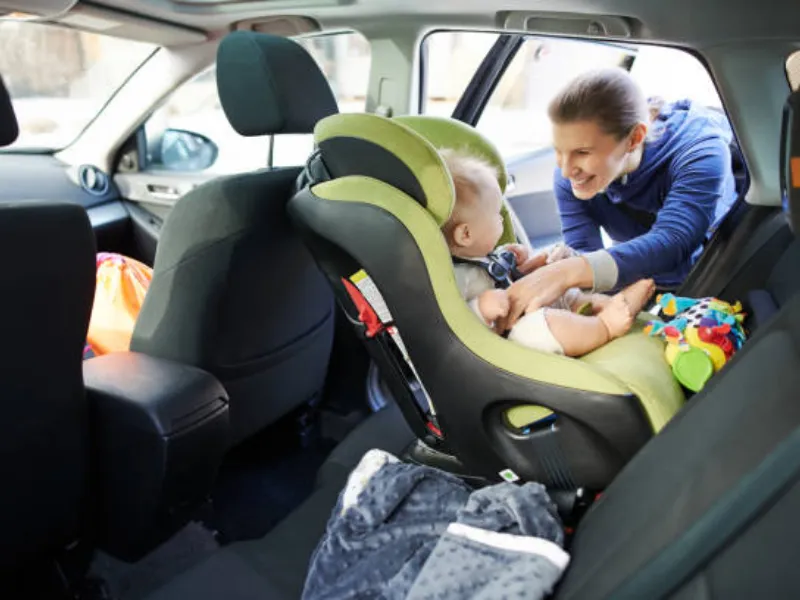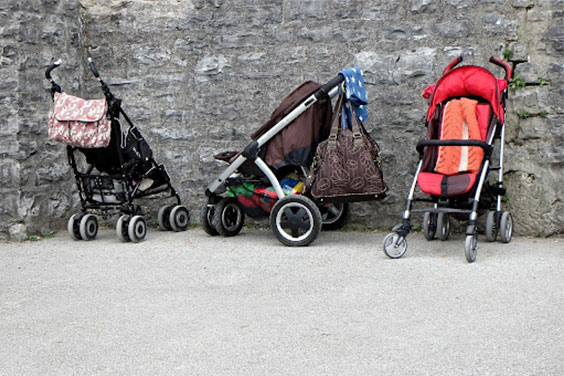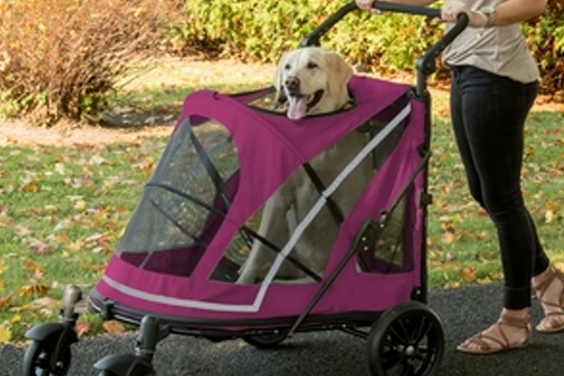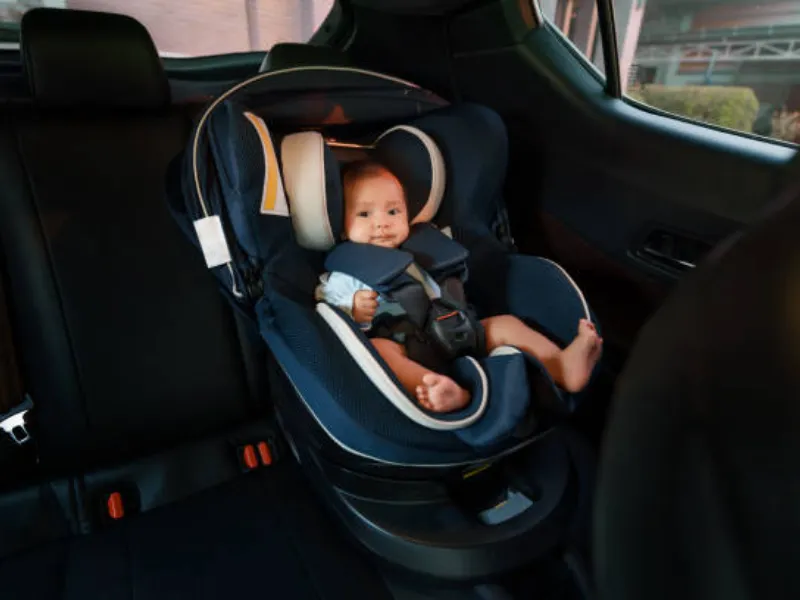The importance of infant car seats and infant car seat safety for children is a subject that cannot be underemphasized. Essential to this is knowing how much a baby should weigh to face forward in a car seat. The necessity is primarily to ensure children’s safety during transit, considering that, unfortunately, motor vehicle crashes remain a leading cause of death for children.
The correct positioning of a child’s car seat while in a vehicle stands as a preventative measure and substantially reduces the risk of fatal injury in case of an accident. The American Academy of Pediatrics (AAP) advises that children should remain in the rear-facing position for as long as possible or until they meet the maximum height- and weight requirements of their car seat for a forward-facing transition. The reason for this is simple: car seat safety matters, and appropriately transitioning the safest position for your child from one seat to another based on their weight and height is paramount to their safety.
Understanding the various child passenger safety guidelines, especially about the appropriate, weight or height for a baby to face forward in a car seat, helps ensure that children are as safe as possible when traveling in an automobile. The more informed parents and caregivers are about these guidelines, the safer children will be.
Are There Specific Laws About When a Baby Can Face Forward in a Car Seat?
Operating by the context of laws can help guide decisions for many parents, or guardians looking for answers to when to sit forward facing up in most convertible seats, and “how much should a baby weigh to face forward in a car seat?” Generally, laws about when a baby can face forward in a car seat can vary by state within countries like the United States.
For instance with convertible car seats, states have different guidelines based on the child’s age, weight, and height. Most state rules for convertible seats advise that babies remain in a rear-facing car seat until they are at least two years old or they exceed the recommended weight and height limit of the car seat, typically around 20 to 40 pounds, upon which they can switch to a forward-facing car seat.
However, the AAP provisions that even beyond fulfilling these laws, the physical features of the difference affects the child in current seat are the best determinant for when to switch to a forward-facing car seat. This is because children can differ significantly in weight and height even if they’re of the same age, reiterating the fact that age alone should not determine when to make the switch to stay rear facing convertible car seat.
Assessing the Correct Weight for a Baby to Face Forward in Car Seats

Establishing the correct weight for a baby to transition to a forward-facing car seat is a crucial aspect of ensuring child safety during transit. According to the AAP, a child should remain in a rear-facing car seat until they reach the weight limit of that type of car seat, highest weight limit which is generally around 20 lbs but can go up to 50 lbs for some modern car seat models.
Once this weight and height limit is reached, or they have exceeded the height limit set by a car seat manufacturer, then they can switch to using a rear facing only seat or a forward-facing car seat. Weight and height limits for both rear-facing and forward-facing car seats differ considerably between different car seat brands and models, so it is always recommended many parents to refer to the owner’s manual of the car seat in question.
| ECE R44 Standard | |||||
| ParameterGroup | 0 | 0+ | I | II | III |
| Applicable weight | <10kg | <13kg | 9-18kg | 15-25kg | 22-36kg |
| Age range | 0-9 months | ||||
| 0-18 months | |||||
| 0-4 years old | |||||
| 0-7 years old | |||||
| 0-12 years old | |||||
| 9 months-12 years old | |||||
| 3-12 years old | |||||
| Installation direction | Rear-facing: weight less than 9kg or age 0-9 months Forward-facing: weight greater than 9kg or age greater than 9 months | ||||
It’s worth noting that keeping a child in a booster seat or a rear-facing car seat for as long as possible is safest, as booster seat and rear-facing car seats provide better support for a child’s head, head and neck back, and spine and are more effective at absorbing the force of a collision.
Car Seat Guidelines for Children
- Follow the car seat manufacturer’s guidelines: Each car seat model will have its own recommendations for when to transition from rear-facing to forward-facing. These guidelines usually take into account the weight and height limits of the car seat. Always consult the manual provided by the manufacturer to ensure you are following their specific instructions.
- Consider your baby’s age, weight, and height: In general, it is safest to keep your baby in a rear-facing car seat for as long as possible. The American Academy of Pediatrics (AAP) recommends that children remain in a rear-facing seat until they reach the maximum weight or height limits specified by the manufacturer.
- Check your local laws: Make sure to familiarize yourself with the laws and regulations regarding car seat usage in your country, state, or region. Some jurisdictions have specific requirements regarding when children can be transitioned to forward-facing seats.
- Evaluate your baby’s development: While weight and height are essential considerations, it’s also crucial to assess your baby’s physical development. They should have good head control and be able to sit up unassisted before transitioning to a forward-facing seat.
- Consider expert recommendations: Organizations such as the AAP and the National Highway Traffic Safety Administration (NHTSA) provide valuable resources and guidelines on car seat safety. Keep up-to-date with their recommendations and research to make informed decisions regarding your baby’s car seat.
Ensuring Safety Precautions
When considering the process of turning your baby or child’s car seat from rear-facing to forward-facing, certain safety tips and guidelines are vital.
Make sure the car seat is properly installed: Ensure that the car seat is being installed correctly and tightly bound into the child comfortable car, the straps and booster seats are tight on the child’s shoulders, and the buckles and clips are in the correct places. Always follow the vehicle seat manufacturer’s instructions for installation.
Secure the tether: For forward-facing seats, always make sure you are securing the seat belt with tether. The tether is a strap that secures the top of the car seat to an anchor in the back of the car. This helps to decrease how far a child’s head is thrown forward during a collision.
Making sure your child is strapped properly into the front forward facing position front-facing car seat is vital. Car seat experts and the National Highway Traffic Safety Administration (NHTSA) have emphasized the need for proper installation of car seats because wrongly installed seats can potentially increase a child’s risk of being severely hurt during a crash.
What Effect Can a Premature Switch to Forward-facing Car Seats Have on My Child?
The ramifications of premature transitioning to a forward-facing car or booster seat, can be dire. Pediatricians, car seat experts, and the AAP all emphasize that premature promoting to a forward-facing car seat can potentially cause more injury to a child passenger safety than a baby during a collision.
- Increased risk of head and neck injuries: Young children’s neck muscles are still developing, and they are unable to withstand the impact forces generated during a collision. Keeping them in a rear-facing car seat longer allows the seat to support their head, neck, and spine, reducing the risk of severe injuries.
- Greater risk of internal injuries: Rear-facing car seats distribute crash forces more evenly across the child’s back and torso, reducing the impact on vital organs. Turning them forward-facing too soon increases the risk of internal injuries to organs like the liver, spleen, and spinal cord.
- Vulnerability to airbag injuries: Passenger seat airbags, which are designed to protect adults, can cause harm to children in a forward-facing car seat. Prematurely placing a child in the front seat exposes them to the risk of airbag deployment during a crash, leading to severe injuries or even death.
- Reduced protection during side-impact crashes: Rear-facing car seats provide excellent protection during side-impact collisions. The shell of the car seat acts as a cushion, absorbing the crash forces and protecting the child’s head, neck, and spine. Switching to forward-facing too early diminishes this protection.
It is important to follow the recommendations of both car seat manufacturers and safety experts regarding when to transition your child from extended rear facing infant seat position and to a forward-facing car seat. The American Academy of Pediatrics (AAP) recommends keeping children in rear-facing car seats until they reach the maximum height and weight limits recommended by the car seat manufacturer, typically between ages 2 and 4.
Conclusion
In summary, the central question of how much should a baby weigh to face forward in a car seat is one that traverses various aspects of infant and convertible car seats, seat, guidelines, laws, and child safety variables. While laws and guidelines provide a basis for making these decisions, it’s essential to understand that these only set the minimum standards.
Each child grows at a different pace, and it’s crucial that parents or guardians make the best convertible seat decision for their child based on their individual needs. Consulting with a pediatrician or a car seat technician just like River Baby can provide additional guidance and reassurance to parents on these matters, ensuring the best seat and utmost safety for many parents and their child on the road.






